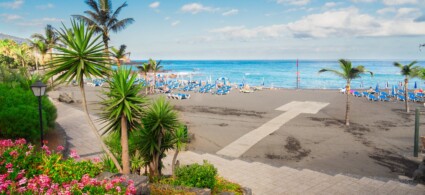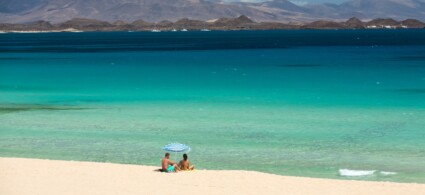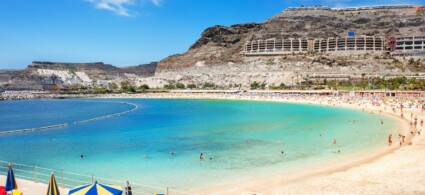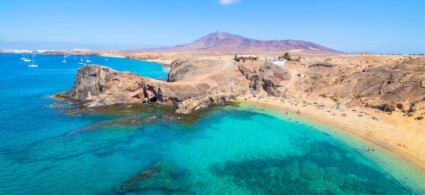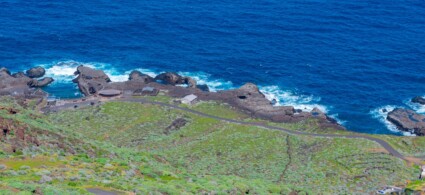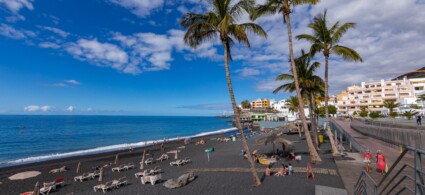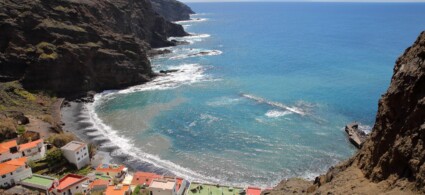

The Canary Islands are famous for their beautiful beaches bathed by crystal-clear waters and set in dramatic natural scenery and for their year-round climate.
The beaches of the Canary Islands are particularly popular among water sports enthusiasts with windsurfing and snorkelling.
On each island of the archipelago you will be spoilt for choice between white sand beaches, volcanic sand beaches, natural saltwater pools and rocky coves.
Among the volcanic beaches not to be missed are Bollullo in the north of Tenerife near La Orotava, Tarajalejo in Fuerteventura near Pajara, Playa del Verodal on the west coast of El Hierro, El Golfo in Lanzarote, Los Cancajos in La Palma, just 4 kilometres from Santa Cruz de La Palma, San Agustin in Gran Canaria and Valle Gran Rey along the south-west coast of La Gomera.
Also very beautiful are the large bay of Las Playitas, the beach of El Cotillo, Corralejo and Playa de Sotavento in Fuerteventura, Playa Socorro, Playa Tejita and Playa Jardin in Tenerife, Punta del Papagayo, Playa la Francesa in Graciosa, Famara in Lanzarote, Maspalomas, Playa del Ingles and Las Canteras in Gran Canaria and Puerto Naos in La Palma.
But naming them all would be pointless, not least because there are seven islands and to visit them all is almost impossible in one holiday. So here are, in our unquestionable opinion, the best 10 beaches in the Canaries!
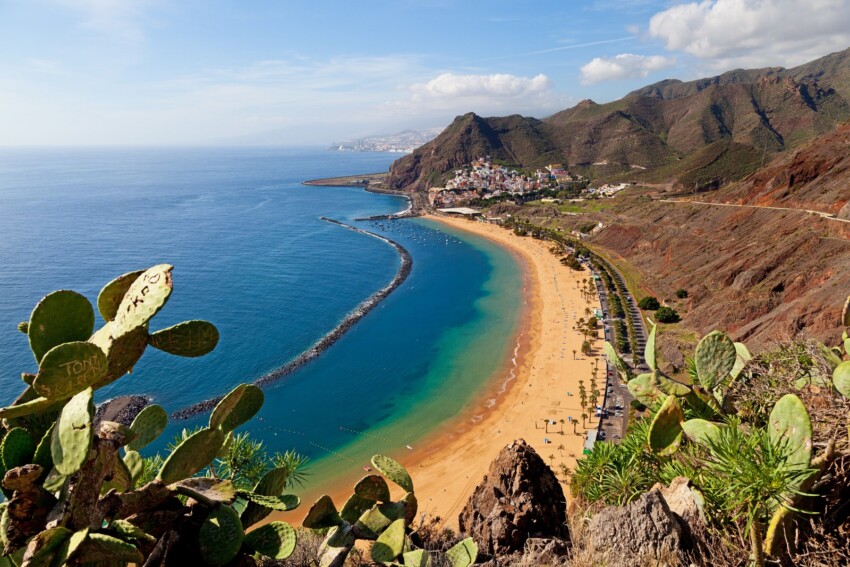
The first of the 10 most beautiful beaches in the Canaries is in Tenerife, not far from its capital Santa Cruz, a stone’s throw from the town of San Andrès. It is Playa de Las Teresitas, very famous and featured in every self-respecting Canarian souvenir shop. Slightly rounded in shape and about a kilometre long, it has fine, golden sand and the seabed slopes gently. It is therefore ideal for children and the elderly, who can bathe without any problem in a safe and protected environment. There is a very convenient car park behind it, although it tends to fill up during the high season.
Las Teresitas beach is largely free, although there are some areas equipped with sunbed and umbrella rentals. There are a couple of beach bars, one in the centre and one at the north-eastern end, and public toilets. In addition, you can take advantage of the palm trees at the end of it to get some natural shade.
Finally, don’t leave Las Teresitas without seeing it from above, by going to the panoramic viewpoint that can be found by driving along the TF-121 road for a couple of kilometres from the western edge of the beach. It is also possible to get there on foot, although the walk is not very pleasant because the road has no pavement, and it is also uphill.
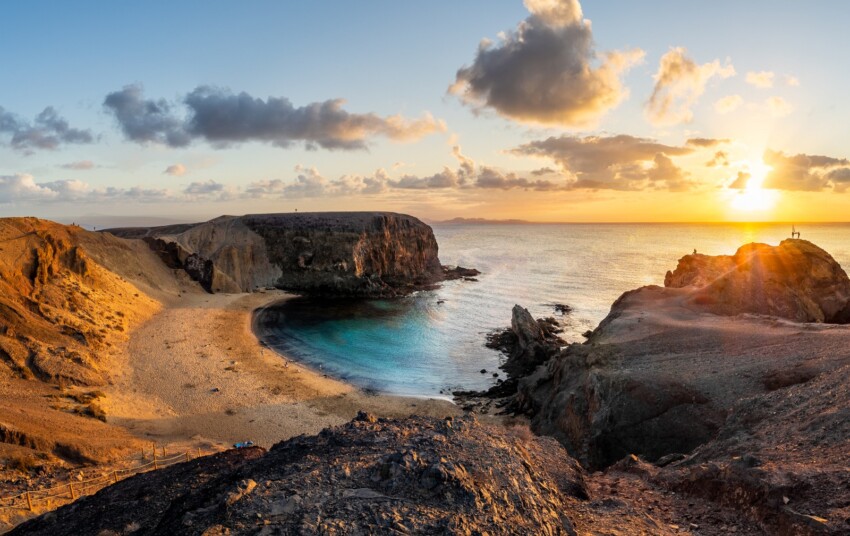
Let us move on to delightful Lanzarote, the most volcanic island of the Canaries. In this strange Garden of Eden, one beach stands out above all others: it is Playa Papagayo, located in the far south, not far from the village of Playa Blanca. The beach is part of the Los Ajaches natural park, and for this reason the surroundings are unspoilt. It is reached by following the park’s driveway to a car park, which fortunately is less than 200 metres from the beach. Once there, the only facilities at your destination are two restaurants, which are not immediately on the beach but about 100 metres from it.
Playa Papagayo is Lanzarote’s most famous postcard; remember that it faces west, so in the afternoon you won’t have any natural shade to rely on, but on the other hand you can enjoy a beautiful sunset.
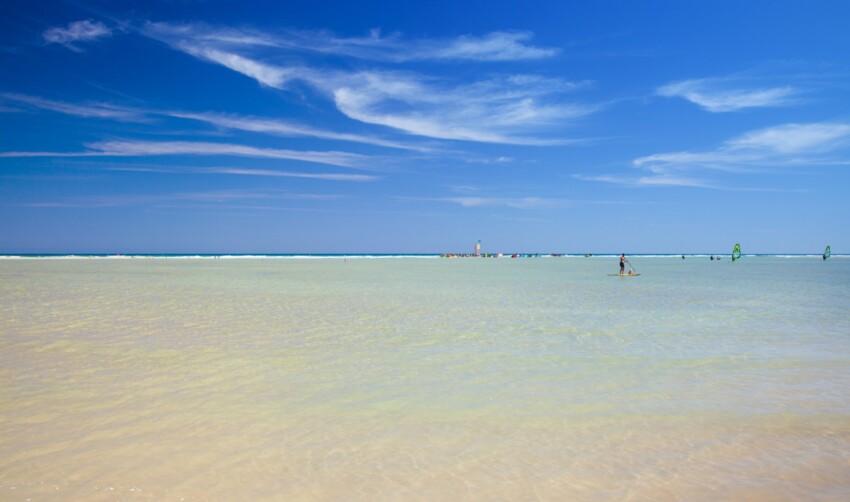
There are many beautiful beaches in Fuerteventura, and of all of them, one of the best is undoubtedly Playa de Sotavento, a true spectacle of nature thanks mainly to the tides, which create natural azure pools where the water is only a few tens of centimetres deep.
The beach, located on the Jandia peninsula in the south of the island, extends inland for several hundred metres, although as mentioned, due to the tides, it often seems much smaller than it actually is. It is often buffeted by winds, which is why it is very popular with surfers and kitesurfers, and why it is not your typical sunbed and umbrella beach. In fact, if you plant your parasol, it is guaranteed to fly away! Very often Playa de Sotavento is used as a photo stop and little else, although of course bathing is not forbidden. But if the wind is strong, watch out for the currents.
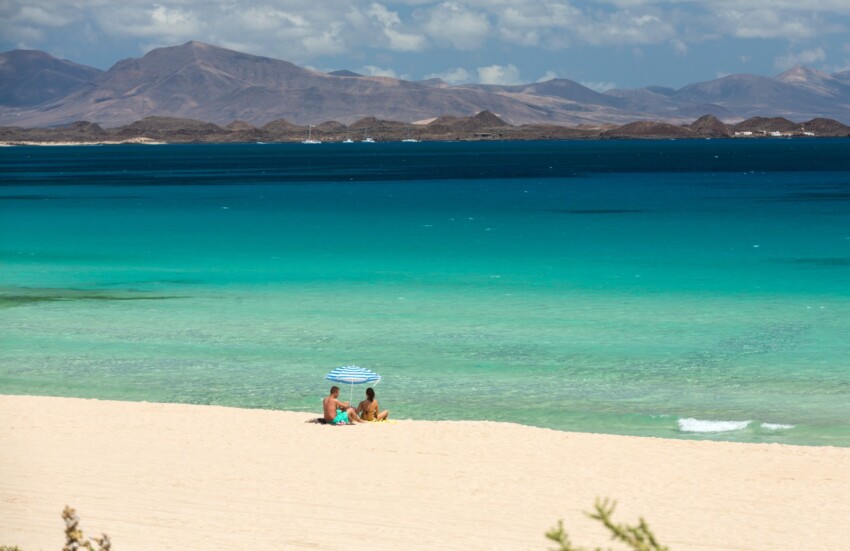
Also in Fuerteventura, if a visit to Playa de Sotavento leaves you with a bitter taste in your mouth because you wanted to dive into the ocean and could not do so because of the wind, there is always an alternative. Head north to Corralejo and enjoy the immensity of the Dunes Natural Park, another spectacle of nature that Fuerteventura is ready to offer to those who decide to visit. Here, the desert flows directly into the sea, creating a single beach more than 10 kilometres long, where you are guaranteed to find at least one corner of total peace, even in high season.
The beach is made of the finest sand, and the sea is exceptionally clear. It is windy but not too windy, and you can lie in the sun without any problems. In some areas of the Corralejo Dunes beach, especially in the north towards the town of the same name, you will also find some beach clubs and beach bars, where you can also rent sunbeds and umbrellas.
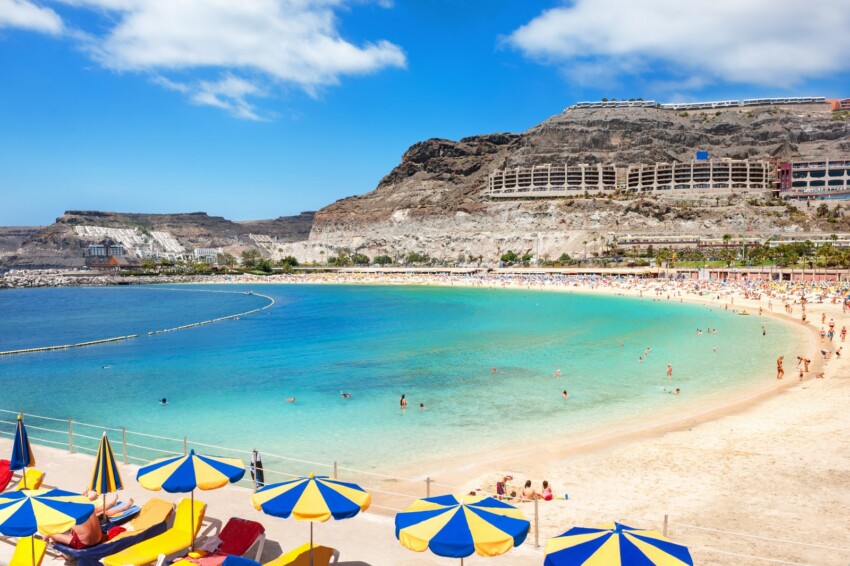
In Gran Canaria, one of the most beautiful beaches is definitely Playa Amadores, which deserves to be named one of the most beautiful beaches in the Canary Islands. It is located on the south coast, on the eastern edge of the town of Puerto Rico. It is a crescent-shaped beach, with sand imported from the Sahara Desert, and therefore very fine and golden.
The beach is for the most part equipped, but there is no shortage of free beach areas where one can spread out one’s towel and open one’s umbrella. Being somewhat of a city beach, Playa Amadores is equipped with all amenities, including public toilets, restaurants and bars, a range of shops, first aid stations and much more. There is also a promenade behind the beach, perfect for a stroll between bathing sessions.
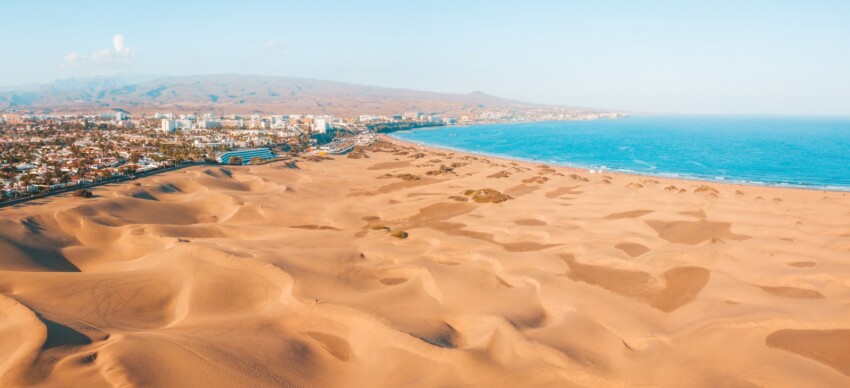
If you are in Gran Canaria and you find yourself in Maspalomas, you will undoubtedly experience an ambiguity. You are in the heart of the island’s nightlife, in a place where practically 90% of the buildings are for tourist use and the language spoken is English. You might think, therefore, that going to the beach you are expecting a kind of Magaluf…. but no! You will find the exact opposite, as by carefully avoiding the (all too) lively Playa del Inglès, you will find yourself in the middle of the desert.
And this is not a figure of speech: south of Maspalomas there really is a desert of about 3 square kilometres, where the famous dunes are the main feature. The desert ends directly in the sea, which guarantees a coastline of about 5 kilometres where you are very likely to find yourself completely alone. So, welcome to the Maspalomas dune beach, a masterpiece forged by nature just a stone’s throw from Gran Canaria’s nightlife. You can even walk inland into the desert instead of towards the sea and find yourself completely alone surrounded by the dunes – a truly unique experience.
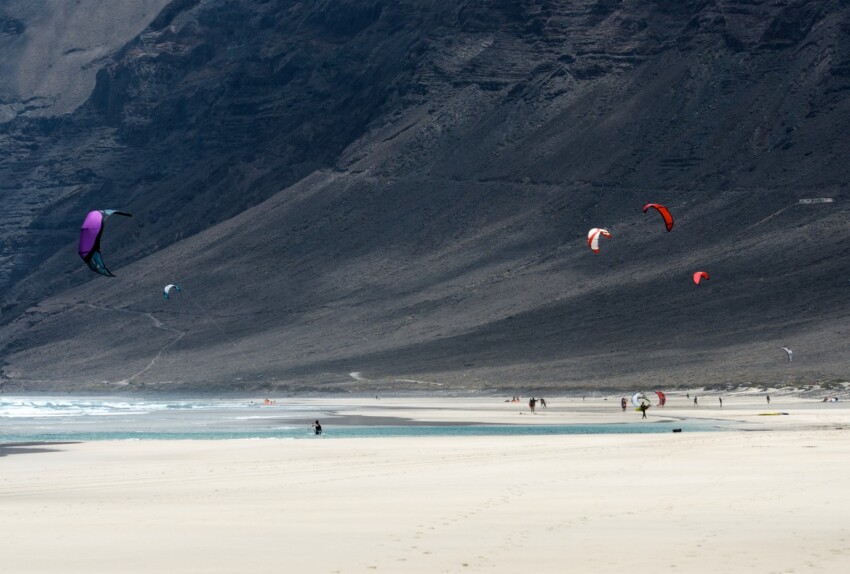
Among the best beaches in the Canary Islands, we have mentioned so far places that are easily accessible and postcard-perfect. Famara is not like that: it is dirty, windy and the sky is always grey, but that is precisely its beauty. A beach at once majestic and menacing, totally removed from mass tourism and clichés.
Located on Lanzarote, Famara faces west and lies behind a mountain range, so it is almost completely shaded in the morning. Cold and inhospitable, the charm of this beach is unique. You will feel as if you are in Northern Europe instead of the Canaries, and bathing is made even more difficult by the sea conditions, which are almost always rough. It is also very windy, which makes Famara a very popular destination for windsurfers, kitesurfers and surfers in general. Its sunsets, on clear days, are unmissable.
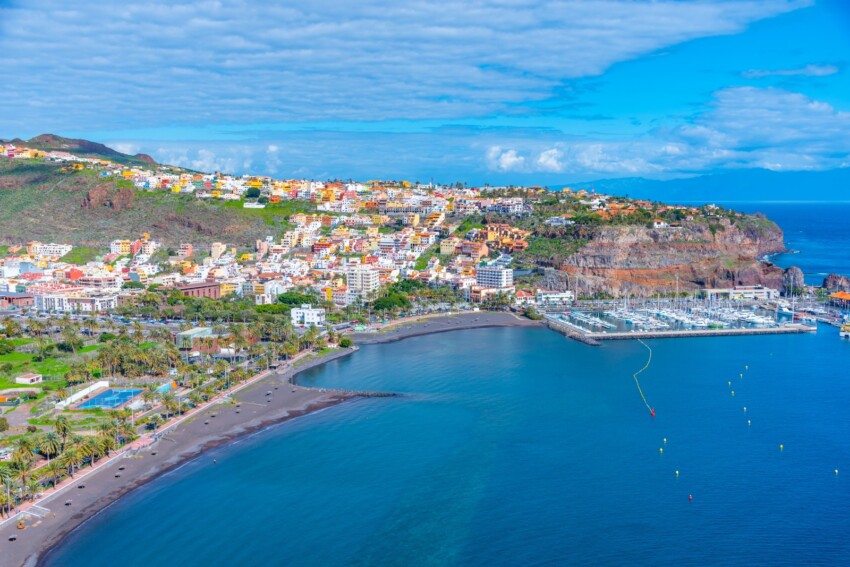
It is now the turn of little La Gomera. This forgotten paradise is only visited by a few thousand tourists a year, but those who have the courage and the will to go this far will be amply rewarded with beautiful landscapes and colonial villages. Nonetheless, La Gomera is still an island, which is why the desire to go to the seaside will start to be felt between a walk and a visit.
The island is not famous for its beaches, but among the many, the city beach in the capital San Sebastian deserves an honourable mention. It is a beach of black volcanic sand, set in a beautiful natural environment, with a driveway and pedestrian promenade behind it. The beach is about one kilometre long, stretching in a north-south direction and ending right at the port of San Sebastian, on the edge of the centre. Despite its proximity to the town centre, Playa de San Sebastian is practically devoid of facilities, except for a few free municipal umbrellas and showers.
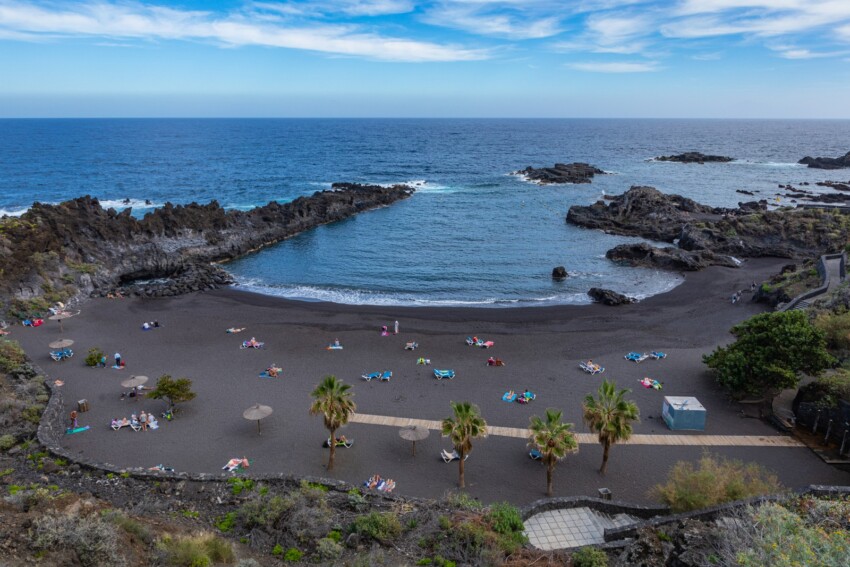
Located on the island of La Palma, Los Cancajos rightfully enters the top 10 most beautiful beaches in the Canary Islands. It is located along the east coast of the island, a few kilometres south of the capital Santa Cruz de La Palma, near the village of Los Cancajos. It is a small, volcanic beach of black sand, often sunny and sheltered from the winds, thanks to the presence of some natural cliffs at its ends.
Playa de Los Cancajos is a free beach, with a pleasant pedestrian promenade behind it. There are a few palm trees that provide shade, some public umbrellas that can be freely used and little else. At the southern edge of the beach is a tourist office where you can obtain information about the island and excursions you can take, as well as a bar and a restaurant.
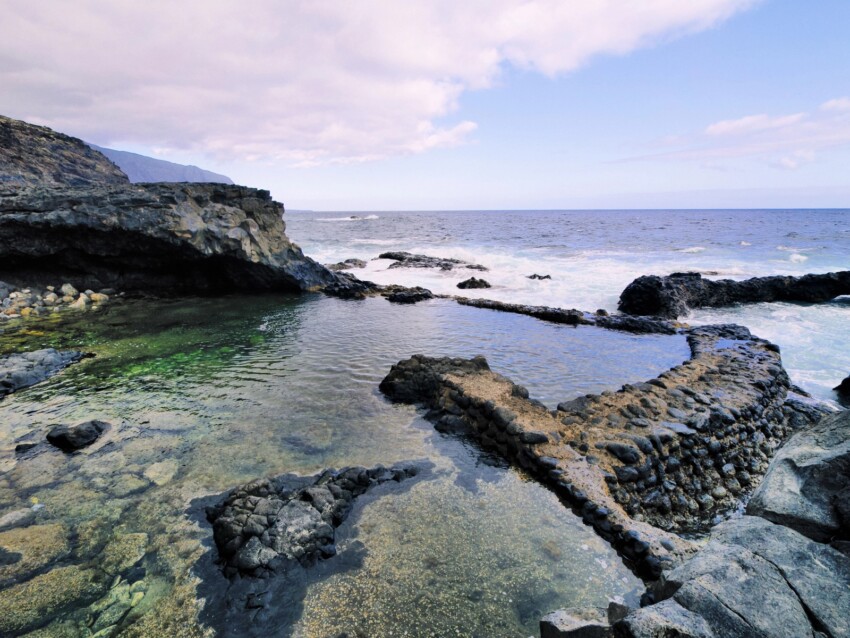
To finish the top 10 best beaches in the Canaries, we move on to the smallest of the seven islands, El Hierro. In this remote outpost, the beaches are small and volcanic, hardly reflecting the typical idea of a tropical beach. However, one of the most beautiful areas on the island is Charco Azul, which technically isn’t a beach at all, but is still a place to bathe.
And what a bath! You can swim in a natural pool at the edge of a cave, in a crazy natural setting. Laying out your towel and opening your umbrella is difficult, however, as we are in the middle of a cliff, although there is a small equipped platform thanks to the presence of a bar.
Beware that there is also a ‘Charco Azul’ in La Palma. Also beautiful, but not as incredible as this one.
In the following map you can see the location of the main places of interest mentioned in this article.
